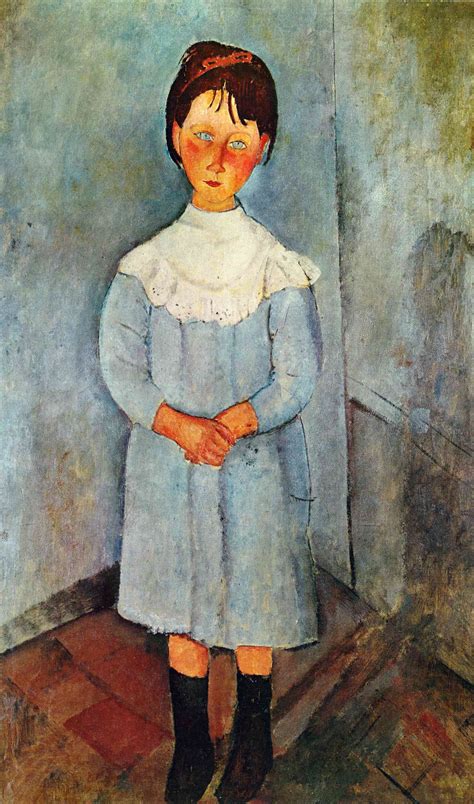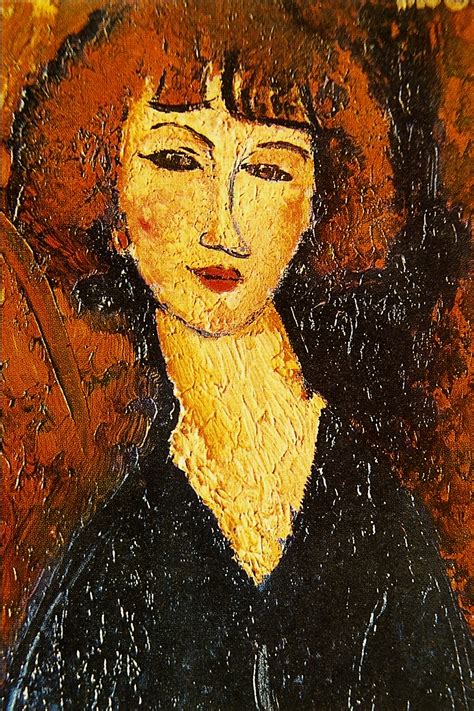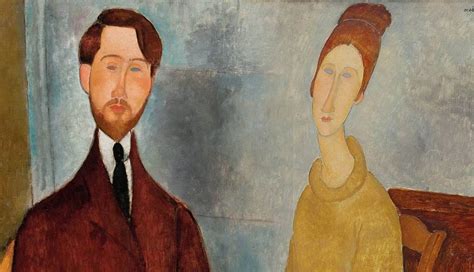Renowned for his exquisite masterpieces and captivating style, the enigmatic Amadeo Modigliani remains an artist of immense intrigue and significance in the art world. With a brush in hand, he painted a symphony of emotions on his canvas, leaving behind a legacy that continues to enthrall art enthusiasts and collectors alike.
Modigliani's unique approach and distinctive aesthetic set him apart from his contemporaries, as he effortlessly combined elements of classicism and modernism to create his own artistic language. His works breathe with life, as if seeking to capture the very essence of the human experience, both in its beauty and vulnerability.
The artist's journey began in Livorno, Italy, in the late 19th century, where he honed his skills and developed a deep appreciation for the arts. Modigliani's innate talent was evident from an early age, as his fervor for creativity ignited a passion that would shape his future and revolutionize the art scene.
Modigliani's oeuvre predominantly consists of portraits, with a focus on the human form. His subjects are rendered with a delicate balance of realism and elegiac abstraction, bringing forth a profound sense of emotion and introspection. Through elongated figures, deep-set eyes, and grace-filled lines, the artist invites us into a world where inner thoughts and unspoken truths find solace on the canvas.
Join us as we embark on a captivating journey into the world of Amadeo Modigliani, exploring the artist's life, inspirations, and the lasting impact of his artistic contributions. Prepare to be captivated by the undeniable allure and profound messages hidden within his seemingly simple strokes. Through his art, Modigliani invites us to reflect on our own humanity and understand the profound beauty that lies in the connection between artist and viewer.
The Early Life of Amadeo Modigliani: Tracing the Influences of Childhood

In this section, we delve into the formative years of the renowned artist Amadeo Modigliani, exploring the various factors and experiences that shaped his artistic journey. From his earliest memories to the influences he acquired during his childhood, Modigliani's upbringing played a pivotal role in shaping his unique artistic style.
As a young child, Modigliani was exposed to a rich tapestry of influences that left an indelible mark on his artistic sensibilities. Growing up in a culturally vibrant community, he was immersed in a world teeming with creativity, diverse perspectives, and a strong appreciation for the arts. From early interactions with local artisans to the vibrant street scenes that unfolded before his eyes, Modigliani's surroundings fueled his innate curiosity and ignited his passion for artistic expression.
- Family Background: Modigliani's family background provided him with a strong foundation for artistic pursuits. With a lineage steeped in creativity and intellectual pursuits, his parents instilled in him a deep appreciation for literature, music, and visual arts from a tender age. Their unwavering support and encouragement helped foster his artistic talents and provided him with the necessary tools to forge his own path in the art world.
- Cultural Influences: The diverse cultural milieu in which Modigliani grew up exposed him to a medley of artistic traditions and styles. Through interactions with artists from various backgrounds, he absorbed elements of classical and contemporary art forms, integrating them seamlessly into his own unique artistic vision. This fusion of influences influenced Modigliani's distinctive approach to portraiture and sculpture, ultimately setting him apart from his contemporaries.
- Nature and Surroundings: The natural beauty of Modigliani's surroundings during his childhood exerted a profound impact on his artistic development. From the rolling hills to the breathtaking seascapes, the awe-inspiring landscapes awakened a sense of wonder within him. Modigliani's deep connection with nature can be seen in his later works, where he masterfully captured the essence of the human form and its intrinsic connection to the world around it.
- Early Education: Modigliani's early education played a crucial role in nurturing his artistic talents. Attending prestigious art schools and receiving formal training provided him with a solid technical foundation, honing his skills and enabling him to experiment with various mediums. This period of instruction and exploration laid the groundwork for his future innovations and artistic breakthroughs.
By tracing the influences of Modigliani's childhood, we gain valuable insights into the origins of his extraordinary artistic prowess. The amalgamation of familial support, cultural exposure, natural surroundings, and formal education shaped the trajectory of his artistic journey, setting him on a path to become one of the most celebrated artists of his time.
Exploring the artist's early years and the influence of his upbringing
In this section, we delve into the formative years of Amadeo Modigliani, examining the profound impact of his upbringing on his artistic journey. We explore the factors that shaped his unique artistic perspective, emphasizing the formative experiences and influences that contributed to his development as an artist.
Childhood and Family: Modigliani's childhood was characterized by a vibrant and culturally rich environment. Growing up in a family that valued creativity and expression, he was exposed to various art forms from a young age. His parents, passionate about literature, music, and visual arts, nurtured his innate curiosity and encouraged his artistic pursuits.
Socioeconomic Background: Modigliani's socioeconomic background played a crucial role in shaping his perspective and artistic approach. Coming from a modest upbringing, he witnessed firsthand the struggles and aspirations of the working class. This exposure to the realities of life instilled in him a deep empathy for the human condition, which later became a prominent theme in his works.
Education and Influences: Modigliani's formal education in art began at an early age, with his parents enrolling him in art classes and providing him with opportunities to learn from established artists. His exposure to various artistic styles, including Renaissance masterpieces and contemporary avant-garde movements, influenced his evolving artistic identity.
Travel and Cultural Encounters: As Modigliani grew older, he embarked on journeys that exposed him to different cultures and artistic traditions. The experience of traveling to different European cities, such as Paris and Rome, broadened his horizons and exposed him to a diverse range of artistic influences.
Personal Challenges and Growth: Modigliani faced personal challenges throughout his life, including health issues, financial instability, and social alienation. These obstacles, while undoubtedly difficult, also played a significant role in shaping his artistic voice. They fueled his introspection and fueled his determination to create art that captured the essence of the human experience.
Overall, exploring Modigliani's formative years and the impact of his upbringing provides crucial insights into the artist's motivations, inspirations, and artistic evolution. The combination of his family's influence, cultural encounters, and personal challenges all played a significant role in shaping the celebrated artist we know today.
The Bohemian Era: Modigliani's Life in Montmartre

In the vibrant and culturally rich neighborhood of Montmartre, a young and enigmatic artist by the name of Amadeo Modigliani found solace and inspiration. This section delves into the captivating period in Modigliani's life when he lived and thrived in the bohemian atmosphere of Montmartre.
During this time, Modigliani immersed himself in the unconventional lifestyle embraced by the artistic community of Montmartre. Surrounded by like-minded individuals, he indulged in late-night discussions, passionate debates, and artistic experiments that defied convention. The air was filled with creative energy and a sense of rebellion, fostering an environment where new ideas could flourish and be celebrated.
Modigliani, with his distinctive style and unique perspective, became a central figure in the Montmartre art scene. His works, characterized by elongated figures, introspective expressions, and a sense of melancholy, captivated both critics and fellow artists. Through his art, he expressed the essence of the bohemian era, capturing its spirit of individuality, passion, and unapologetic self-expression.
Montmartre became Modigliani's muse, inspiring him to create some of his most renowned paintings and sculptures. The narrow streets, bustling cafés, and eclectic characters provided endless inspiration for his artistic exploration. From the bohemian women he encountered to the vibrant nightlife, every aspect of Montmartre found its way into Modigliani's art, giving it a distinctive and alluring charm.
In this section, we delve into the lasting impact that Montmartre had on Modigliani's life and works, exploring how the bohemian era shaped his artistic journey and allowed him to carve his own path in the art world.
Unveiling the artist's experiences and affiliations in the vibrant artistic community of Montmartre
Delve into the captivating world of renowned painter Amadeo Modigliani and explore the captivating realm he inhabited within the bustling and diverse artistic community of Montmartre. Montmartre, a vibrant neighborhood in Paris, served as a breeding ground for artistic innovation, as well as a magnet for avant-garde artists, writers, and intellectuals during the early 20th century.
In this section, we will delve into Modigliani's immersive experiences and associations within Montmartre's artistic milieu, where creative minds converged, ideas clashed, and artistic revolutions were sparked. Through his interactions with fellow artists, writers, and patrons, Modigliani not only carved his path as a painter but also participated actively in the intellectual and cultural debates that shaped the era.
Montmartre provided the perfect backdrop for Modigliani's artistic growth, offering him a network of like-minded individuals who shared his passion for pushing boundaries and challenging traditional artistic norms. The neighborhood's bohemian atmosphere was abuzz with the exchange of ideas and artistic experiments, providing fertile ground for Modigliani to refine his distinctive style and find his artistic voice.
Among his peers and associates in Montmartre, Modigliani formed lasting friendships and artistic collaborations that left an indelible mark on his work. Artists such as Pablo Picasso, Constantin Brâncuși, and Amedeo Modigliani paved the way for modern art, sharing their ideas, critiques, and inspiration within the vibrant and diverse artistic community.
Modigliani's experiences in Montmartre also exposed him to the financial and emotional struggles that often accompanied the artist's life. The neighborhood's unconventional lifestyle and free-spirited ethos deeply influenced Modigliani's bohemian existence, with its transient relationships, artistic sacrifices, and the pursuit of creative freedom at all costs.
Through this exploration of Modigliani's encounters and associations within Montmartre, we gain a deeper understanding of the powerful influence this dynamic environment had on his art and the significant role he played in shaping its cultural landscape. Join us as we unravel the intertwined stories of Modigliani and the vibrant artistic community that propelled him towards artistic renown.
The Elegance of Simplicity: Modigliani's Distinctive Style

In a world often preoccupied with complexity, Italian artist Amadeo Modigliani sought solace and beauty in simplicity. He embraced a distinctive style characterized by understated elegance, capturing the essence of his subjects with minimalistic yet profound strokes.
Subtle yet impactful, Modigliani's works convey a sense of serenity and sophistication. Through his masterful use of lines, he created figures that exuded grace and poise, transcending the boundaries of time and place. Each stroke was deliberate and purposeful, conveying a deep understanding of the human form and spirit.
Modigliani's unique approach to portraiture stripped away superfluous details, allowing the essence of the subject to shine through. His paintings often featured elongated faces and necks, creating an otherworldly quality that mesmerized viewers. This deliberate distortion served as a gateway to the soul, revealing the innermost emotions and vulnerabilities of his subjects.
The simplicity of Modigliani's style did not equate to lack of depth; instead, it emphasized the raw humanity and profound beauty that lay beneath the surface. His works showcased the interconnectedness of the human experience, capturing the universal emotions of love, longing, and melancholy. Each brushstroke was saturated with emotion, evoking a visceral response in those who gazed upon his creations.
Modigliani's distinctive style continues to captivate art enthusiasts across the globe, standing as a testament to the timeless allure of simplicity. His works serve as a reminder that true artistry lies not in complexity, but in the ability to distill the complexities of life into a single, evocative image. Modigliani's legacy as a master of simplicity remains unparalleled, inspiring generations to embrace the elegance and purity that can be found in the most uncomplicated of forms.
An in-depth analysis of the artist's iconic elongated figures and their artistic significance
The exploration of Amadeo Modigliani's renowned artistic style delves into the captivating world of his iconic elongated figures, examining their profound artistic significance. These distinctive portrayals, characterized by their elongated features and simplified forms, epitomize Modigliani's artistic vision and leave a lasting impression on viewers.
Modigliani's elongated figures, with their exaggerated proportions and slender forms, evoke a sense of grace and elegance, evoking comparisons to the timeless beauty of ancient sculptures. Through his unconventional approach, the artist challenges traditional notions of representation, embracing a stylized realism that emphasizes the expressive power of line and form.
The elongation of the figures in Modigliani's works serves as a visual metaphor for the artist's exploration of the human condition. By elongating his subjects, he emphasizes their vulnerability and fragility, inviting us to contemplate the complexities of the human experience. This distortion of proportions elicits an emotional response, drawing viewers into a deeper understanding of the figures' inner worlds.
Moreover, the elongated figures in Modigliani's art offer a unique perspective on identity and individuality. Through his distinct portrayal of facial features, the artist captures the essence of his subjects, going beyond mere physical likeness. The elongated faces and necks become symbolic representations of the inner essence of his sitters, revealing their inner thoughts and emotions.
Modigliani's utilization of elongation also breathes life into his compositions, creating a sense of rhythm and harmony. The elongated forms flow seamlessly within the confines of the canvas, capturing the viewer's attention and guiding their gaze across the artwork. This deliberate distortion of proportions creates a dynamic tension, enhancing the overall visual impact of the piece.
In conclusion, Amadeo Modigliani's iconic elongated figures hold immense artistic significance, both visually and symbolically. They challenge traditional conventions of representation, offering an evocative exploration of the human condition and inviting viewers to delve into the depths of the figures' inner worlds. Through his masterful use of elongation, Modigliani leaves a lasting impression and continues to be celebrated as a visionary artist.
The Scandalous Portraits: Love, Obsession, and Modigliani's Artistic Expression

Delving into the captivating world of Amadeo Modigliani's art, one cannot ignore the scandalous allure of his portraits. These mesmerizing works not only showcase Modigliani's unique style and artistic genius but also reflect the deep emotions, love, and obsession that fueled his creative expression.
Within his scandalous portraits, Modigliani masterfully captures the essence of human beings, their desires, and their vulnerabilities, transforming brushstrokes into whispers of passion and longing. It is through this lens that he unveils the inner turmoil and raw emotions of his subjects, creating a dialogue between the artist, his models, and the viewer.
Love, a central theme in Modigliani's scandalous portraits, becomes palpable within each stroke of his brush. The artist's infatuation with his subjects is evident in their ethereal beauty and sensuality, paying homage to the intimate relationships that defined his life. Whether capturing the intense gaze of a lover or the tender embrace of a muse, Modigliani's portraits blur the boundaries between art and reality, inviting us to explore the complexities of human connection.
Obsession, another driving force behind Modigliani's scandalous portraits, manifests in the artist's relentless pursuit of perfection. His unyielding commitment to capturing the essence of his subjects imbues his works with an undeniable sense of longing and desire. Each stroke, each contour, becomes a manifestation of Modigliani's passion, leaving the viewer mesmerized by the intensity and vulnerability portrayed on the canvas.
Modigliani's artistic expression, showcased through these scandalous portraits, is a testament to the innovative spirit that defined the early 20th-century art scene. With his distinctive style characterized by elongated figures, almond-shaped eyes, and sensual curves, Modigliani challenged societal conventions and pushed the boundaries of traditional portraiture. His art became a vessel through which he navigated the intricacies of human existence, offering a profound glimpse into the emotions that bind us all.
Steeped in controversy, Amadeo Modigliani's scandalous portraits continue to captivate audiences today. Through his remarkable ability to capture love, obsession, and the raw essence of human emotions, Modigliani leaves an indelible mark on the art world, reminding us that true artistic expression cannot exist without vulnerability, passion, and an unyielding belief in the power of the human spirit.
FAQ
Who is Amadeo Modigliani?
Amadeo Modigliani was an Italian painter and sculptor, known for his distinctive style and portrayal of the human figure. He was born in Livorno, Italy in 1884 and died in Paris, France in 1920. Modigliani's artwork is characterized by elongated figures, smooth lines, and a sense of melancholy. Despite his relatively short career, he left a lasting impact on the art world.
What are some notable works by Amadeo Modigliani?
Amadeo Modigliani created numerous notable works, including his famous series of portraits. Some of his most renowned paintings include "Nude Sitting on a Sofa," "Portrait of Jeanne Hébuterne," and "Reclining Nude." Modigliani's sculptures, although fewer in number, are highly regarded as well. One of his most iconic sculptures is "Head of a Woman." His unique artistic style and ability to capture emotions through his art continue to resonate with audiences today.
What challenges did Amadeo Modigliani face during his career?
Amadeo Modigliani faced several challenges throughout his career. One major obstacle was his struggle with poor health, particularly due to tuberculosis. This constant battle with his health affected his ability to work consistently and led to a tragic and premature death at the age of 35. Additionally, Modigliani faced criticism and rejection from the art establishment during his lifetime. Many of his works were considered controversial and not widely accepted at the time. However, his artistic vision and unique style eventually gained recognition and admiration after his death.



